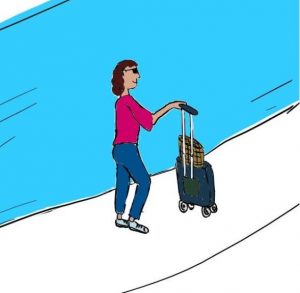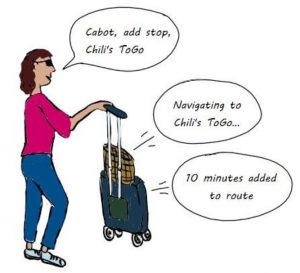Problem Description

Cabot is an assistive robot designed to help visually impaired users navigate through a new
environment. The user will use this suitcase-shaped robot to aid them in traversing new indoor
environments. Many studies and experiments have shown that visually impaired users struggle
with traditional navigation techniques. Users still use guide dogs and canes in order to navigate
areas. However, these methods do not provide essential information about the path the person
needs to travel or their final destination. There are also communication issues with these type of
solutions. For example, guide dogs, although highly trained, are unable to consistently
communicate with their users about their intent. The visually impaired users, in turn, have
problems relaying their wishes to the guide dog.
One current solution that is being tested is NavCog, a phone app based navigation assistant
specifically designed for the visually impaired. It has some limitations as it is unable to provide
information on obstacles in the path that have not previously been mapped. Visually impaired users
also prefer having humans to guide them and having something grounded to trust. We hope to
provide a solution for all these shortcomings in the current solutions to guide and assist blind users.
Cabot needs to be in a symbiotic relationship with its user to provide an effective platform to guide
them through new indoor environments.
We envision the solution to be of no hassle to the user and available to pick up in public areas
where they will be necessary. This alleviates the burden of visually impaired people having to
carry around and store their canes or take care and support their dogs
Use Case
Maria, a visually impaired woman from Pittsburgh, is on the way to Pittsburgh International
Airport to catch a flight home to her daughter’s wedding. She currently uses a cane on a daily basis
in order to walk around to the destinations she needs to reach, but she has never been to this airport
before. Maria is becoming nervous about navigating on her own in this unfamiliar and crowded
location. As she leaves her Uber, Maria uses her cane to feel for the curb and enters through the
airport’s automatic doors. An attendant by the door asks if Maria needs any assistance arriving to
her gate, and offers help from their new assistive robot, Cabot, which Maria decides to accept, as
depicted in the below figure.

Pittsburgh International previously mapped out the floorplan of the airport and
placed Bluetooth beacons around the halls for Cabot’s navigation and localization requirements. The
attendant helps Maria enter her flight details into the Cabot user interface. The interface alerts the
flight attendants to the arrival of Maria, will update Cabot with any new gate changes, and tells
Maria which gate they will be navigating to. Maria places her purse and foldable cane into the
basket on top of the robot. Cabot asks Maria if she would like a functional overview to describe
all of the Cabot features, which she agrees to by verbally stating “Yes”. The overview recommends
Maria to push Cabot in front of her in order to best detect obstacles. Voice commands that Maria
can use are also provided, such as “help desk,” “restroom,” and “food.” Once done, Cabot asks if
Maria is ready to proceed to her gate, which she again replies, “Yes.” Cabot navigates to the
security line available for Cabot users, using motorized wheels, slowing down adapting to the
pedestrians in front of the robot. On the way to the security line, there is a suitcase in the path of
Cabot, which verbally warns Maria and vibrates the handle once it is about to turn to go around
the obstacle. Once the obstacle is out of the path, the handle vibrates again and a “ping” is heard,
letting Maria know that the way is clear again.
Once Maria gets through security, she says “time” to Cabot, which responds, “Your flight
leaves in 45 minutes, the current time is 4:55pm.” Maria decides that there is time for food, and
says “food” to Cabot. Cabot states, “The food destinations around you include: “McDonalds,” 3
minutes off route, “Chili’s ToGo,” 5 minutes off route, and “Macaroni Grill,” 10 minutes off route.

Would you like to hear more options?” Maria responds “no, add stop, Chili’s ToGo.” Cabot
navigates to “Chili’s ToGo,” using vibrations before each turn and a ping after each turn is
complete. Cabot confirms to Maria when she has arrived. After eating, Cabot continues on the
route to Maria’s gate, bringing her to the information desk. Upon arrival, Cabot says “You have
arrived to your gate, your flight will board in 5 minutes.” An attendant helps Maria to an empty
seat and Maria returns Cabot to an attendant when boarding her flight.